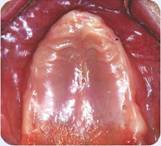
Treatment of an edentulous patient with conventional complete denture prostheses
CASE STORY
A 62-year-old completely edentulous Caucasian male presents requiring maxillary and mandibular complete dentures to restore form, function, and aesthetics. He has been edentulous in the maxilla for the past 15 years and had his mandibular anterior incisors extracted about 8 months ago. He presents with a chief complaint of: “I need new teeth (dentures).” The patient states that his present dentures are ill-fitting and they move when he eats and speaks. Intraoral examination reveals moderately inflamed oral tissues, consistent with an ill-fitting denture; however, the amount of alveolar bone present is adequate for denture support.
Figure 1: Preoperative maxilla.

Figure 2: Preoperative mandible.

LEARNING GOALS AND OBJECTIVES
- Manage soft tissues prior to prostheses fabrication.
- Determine and reestablish proper vertical dimension of occlusion (VDO).
- Assess anterior artificial tooth arrangement.
- Recognize and treat common postinsertion sequelae.
Medical History
- Diabetes: diagnosed at the age of 17, well controlled with medication
Dental History
- Extraction of maxillary teeth 15 years ago and the remaining mandibular anterior teeth 8 months ago; patient states that all extractions were due to “gum disease.”
- The patient soaks his dentures at night in water but does not brush them; however, he does rinse his mouth with mouthwash daily before reinserting the dentures.
- His diet is described as normal, but lately consisting of softer food.
Medications and Allergies
- Metformin (Glucophage) 500 mg twice daily
- Multivitamin daily
Review of Systems
- Diabetes mellitus type ll
- Vital signs:
- Blood pressure: 129/78
- Heart rate: 72 beats/minute
- Respiratory rate: 16 breaths/minute
Social History
- Smoking: cigarettes, one pack per day since the age of 15
- Alcohol: 2-3 pints of beer daily
- Recreational drugs: denies having ever used them
Extraoral Examination
- Head: normocephalic, symmetrical, no masses or scars
- Neck: within normal limits
- Muscles: within normal limits
- Lymph nodes: within normal limits
- TMJ: no clicks, pops, or tenderness; normal range of motion; no deviation on opening or closing
Soft Tissue Examination
- Lips: moist; symmetrical; normal shape, size, and color, with mild angular cheilitis present
- Mucosa: mildly inflamed; patent Stenson’s duct; no masses, scars, or lesions
- Hard palate: normal size and shape with nicotinic stomatitis present
- Soft palate: slightly erythematous, normal size and shape
- Tongue: normal size and shape; no masses, scars, or lesions; candida overgrowth present leaving erythematous palatal mucosa when rubbed off
- Saliva: appears to be of normal flow and consistency (Examination of soft tissues and salivary flow rate are important considerations when planning for and constructing a new complete denture.)
- Floor of mouth: Patent Wharton’s duct; no masses, scars, or lesions. (Examination of soft tissues and salivary flow rate are important considerations when planning for and constructing a new complete denture.)
- Oral cancer screen: negative for clinical signs of oral cancer. (Examination important because of history of smoking and alcohol consumption.)
Clinical Findings/Problem List
- Complete edentulism
- Inadequate oral hygiene
- Inadequate existing complete dentures
- Poor masticatory function
Diagnosis
- Complete edentulism
- Angular cheilitis
- Candidiasis
- Nicotinic stomatitis
- Insufficient vertical dimension of occlusion (VDO)
Clinical Decision-Making Determining Factors
- Edentulism is defined as having no teeth and is usually the result of dental caries and/or periodontal disease. The remaining residual ridge can undergo remodeling and resorption often with an unpredictable pattern. This can result in the instability of the complete dentures. Adequate ridge height and width must be carefully evaluated in the fabrication of complete dentures (Slagter, Olthoff et al. 1992; Eklund and Burt 1994; Carlsson 2004).
- Denture retention and comfort are directly related to the supporting tissues of the residual ridge. Sufficient vestibular depth/>
Stay updated, free dental videos. Join our Telegram channel

VIDEdental - Online dental courses


